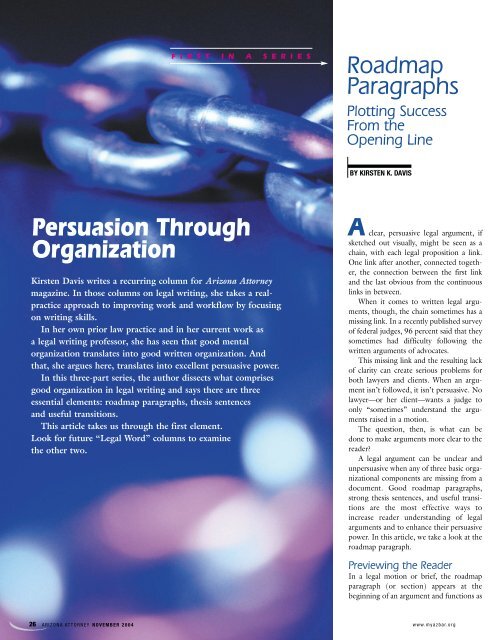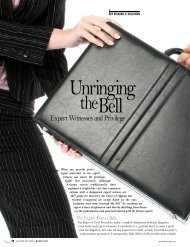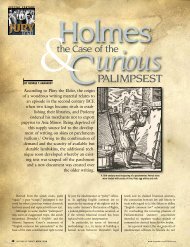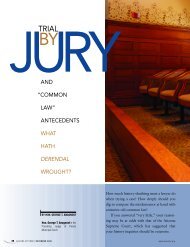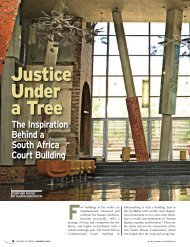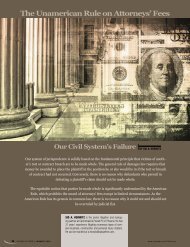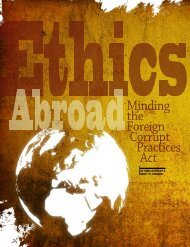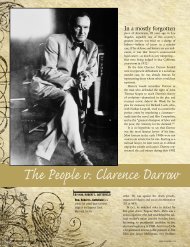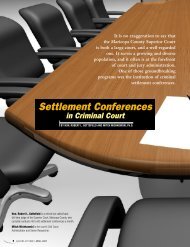Persuasion Through Organization - Lawyers
Persuasion Through Organization - Lawyers
Persuasion Through Organization - Lawyers
Create successful ePaper yourself
Turn your PDF publications into a flip-book with our unique Google optimized e-Paper software.
F I R S T I N A S E R I E S<br />
Roadmap<br />
Paragraphs<br />
Plotting Success<br />
From the<br />
Opening Line<br />
BY KIRSTEN K. DAVIS<br />
<strong>Persuasion</strong> <strong>Through</strong><br />
<strong>Organization</strong><br />
Kirsten Davis writes a recurring column for Arizona Attorney<br />
magazine. In those columns on legal writing, she takes a realpractice<br />
approach to improving work and workflow by focusing<br />
on writing skills.<br />
In her own prior law practice and in her current work as<br />
a legal writing professor, she has seen that good mental<br />
organization translates into good written organization. And<br />
that, she argues here, translates into excellent persuasive power.<br />
In this three-part series, the author dissects what comprises<br />
good organization in legal writing and says there are three<br />
essential elements: roadmap paragraphs, thesis sentences<br />
and useful transitions.<br />
This article takes us through the first element.<br />
Look for future “Legal Word” columns to examine<br />
the other two.<br />
A clear, persuasive legal argument, if<br />
sketched out visually, might be seen as a<br />
chain, with each legal proposition a link.<br />
One link after another, connected together,<br />
the connection between the first link<br />
and the last obvious from the continuous<br />
links in between.<br />
When it comes to written legal arguments,<br />
though, the chain sometimes has a<br />
missing link. In a recently published survey<br />
of federal judges, 96 percent said that they<br />
sometimes had difficulty following the<br />
written arguments of advocates.<br />
This missing link and the resulting lack<br />
of clarity can create serious problems for<br />
both lawyers and clients. When an argument<br />
isn’t followed, it isn’t persuasive. No<br />
lawyer—or her client—wants a judge to<br />
only “sometimes” understand the arguments<br />
raised in a motion.<br />
The question, then, is what can be<br />
done to make arguments more clear to the<br />
reader?<br />
A legal argument can be unclear and<br />
unpersuasive when any of three basic organizational<br />
components are missing from a<br />
document. Good roadmap paragraphs,<br />
strong thesis sentences, and useful transitions<br />
are the most effective ways to<br />
increase reader understanding of legal<br />
arguments and to enhance their persuasive<br />
power. In this article, we take a look at the<br />
roadmap paragraph.<br />
Previewing the Reader<br />
In a legal motion or brief, the roadmap<br />
paragraph (or section) appears at the<br />
beginning of an argument and functions as<br />
26 ARIZONA ATTORNEY NOVEMBER 2004 www.myazbar.org
a persuasive preview of what’s to come in<br />
the remainder of the argument. The<br />
roadmap paragraph is important because it<br />
(1) facilitates the reader’s understanding of<br />
the legal argument and (2) meets the reader’s<br />
need to evaluate the argument as it is<br />
made and to be able to see how the argument<br />
is organized.<br />
Studies on brain hemispheric preferences—left-brained<br />
thinking or rightbrained<br />
thinking—show that readers will<br />
learn the most from (and thus better<br />
understand) a document that has a<br />
roadmap paragraph. Why is that the case?<br />
The roadmap paragraph appeals to leftbrained<br />
thinkers by providing a step-bystep<br />
outline of the argument, enabling<br />
them to better understand the argument<br />
details as they are added in the body of the<br />
document. Conversely, right-brained<br />
thinkers find roadmap paragraphs useful<br />
because it gives them the overview of the<br />
argument. The “big picture” keeps rightbrained<br />
thinkers from getting mired in the<br />
same details that left-brainers love, allowing<br />
them to better understand the argument<br />
from a broader vantage point.<br />
The roadmap paragraph also allows<br />
legal readers to begin to evaluate the arguments<br />
raised in written advocacy immediately<br />
as well as to see how those arguments<br />
are organized. Legal readers tend to be<br />
skeptical readers. As a result, they want to<br />
know up front what arguments are being<br />
made so they can test how well the law and<br />
facts support those arguments. In fact, 76<br />
percent of federal judges said a roadmap<br />
paragraph was important.<br />
www.myazbar.org<br />
NOVEMBER 2004 ARIZONA ATTORNEY<br />
27
<strong>Persuasion</strong> <strong>Through</strong> <strong>Organization</strong>: PART I<br />
Moreover, a roadmap paragraph outlines for the reader how the<br />
legal arguments will be divided and discussed. For example, if the paragraph<br />
divides the arguments into two issues, each with three elements<br />
to be examined, the reader will expect that the writer will address each<br />
issue in order and will break down the discussion of each issue into the<br />
three elements described in the roadmap.<br />
Plotting the Map<br />
Here is an example of a good, albeit basic, roadmap paragraph from a<br />
fictitious memorandum in support of a motion for change of venue<br />
based on a recent California case:<br />
The widespread and negative media reports surrounding<br />
this case have made it impossible to seat a fair and impartial<br />
jury in Imperial County. Courts consider five factors in<br />
determining whether to grant a change of venue when<br />
there has been the dissemination of material in the community<br />
prejudicial to the defendant. Martinez v. Superior<br />
Ct., 29 Cal. 3d 574, 583 (1981). If (1) the consequences<br />
to the defendant are grave, (2) the community is small, (3)<br />
the victim enjoys celebrity status, (4) the defendant is vilified<br />
in the community, or (5) there are political overtones<br />
in the case, the court should grant a motion for a change of<br />
venue. See id. Here, Mr. Jones is facing a grave consequence—the<br />
death penalty. Second, Imperial County is<br />
small county of only 500,000 residents; coupled with the<br />
daily negative media coverage of this case, this fact weighs<br />
in favor a venue change. Furthermore, the victim is revered<br />
by the community, while Mr. Jones has been characterized<br />
as an outsider. Finally, the political overtones, as evidenced<br />
by the County Attorney’s comments, have surrounded this<br />
case and are a separate and independent reason for a change<br />
of venue.<br />
This paragraph illustrates the three components of a basic but persuasive<br />
roadmap paragraph: the legal conclusion, the summary of the law, and<br />
the summary of the factual analysis.<br />
First, the roadmap paragraph gives the writer’s overall conclusion on<br />
the legal issue being argued. Of course, more could be added to bolster<br />
that conclusion, such as facts about the nature of the media reports<br />
being generated about the crime and the trial. But, at the<br />
Kirsten K. Davis<br />
is a regular<br />
contributor to<br />
ARIZONA ATTORNEY<br />
magazine. She is a<br />
Legal Writing<br />
Professor<br />
at the Arizona<br />
State University<br />
School of Law.<br />
very least, the opening sentence tells the reader what conclusion<br />
should be drawn from the argument that follows.<br />
Second, the paragraph summarizes the law on the<br />
issue. Here, the writer has indicated that this is a factor<br />
test—one in which not all of the listed items must be satisfied<br />
to meet the test—and has written the rule to suggest<br />
the outcome he advocates. For example, the writer<br />
does not say the court must consider “the size of the<br />
community” but instead says that the court should grant<br />
the motion if the “community is small.”<br />
In the body of the motion, the reader will expect to<br />
see case law cited that supports the writer’s conclusion that the court<br />
should grant a change of venue motion when communities are small as<br />
28 ARIZONA ATTORNEY NOVEMBER 2004 www.myazbar.org
well as an argument that this community is<br />
small by precedent standards. By using a<br />
numbered list to describe the rule, the<br />
writer is creating an expectation that the<br />
analysis will be divided into five parts, one<br />
part for each factor. If the writer does not<br />
use this organization for the remainder of<br />
the argument, the reader will be confused.<br />
Finally, the roadmap paragraph summarizes<br />
the factual basis for the legal conclusion<br />
and highlights those facts that are most<br />
important to the writer’s position and that<br />
will be further discussed in the motion.<br />
Note that the writer uses specific detail for<br />
facts that he wants the reader to remember.<br />
Roadmap paragraphs can be used at the<br />
beginning of documents and at the beginning<br />
of sections. They should include conclusions<br />
about the outcome of issues, summaries<br />
of the law to be applied, and summaries<br />
of the factual analysis.<br />
Why the Paragraph Works<br />
The roadmap paragraph appeals to both<br />
left- and right-brained thinkers. The leftbrainers<br />
will appreciate the five steps in analyzing<br />
the venue question. The right-brainers<br />
will appreciate seeing the whole picture<br />
before getting into the details of each factor.<br />
In summary, roadmap paragraphs help<br />
the reader understand written legal arguments.<br />
They give a preview of what’s to<br />
come later in the argument and provide a<br />
framework of conclusions, law and facts in<br />
which to organize the remaining details of<br />
the argument. Thus, because they are more<br />
easily understood, the arguments are more<br />
persuasive.<br />
Upcoming articles will detail the value<br />
AZ<br />
of thesis sentences and useful transitions. AT<br />
endnotes<br />
1. Kristen K. Robbins, The Inside Scoop: What<br />
Federal Judges Really Think About the Way<br />
<strong>Lawyers</strong> Write, 8 LEG. WRITING 257, 272<br />
(2002).<br />
2. For an easy read on learning preferences and<br />
styles, see RICKI LINKSMAN, HOW TO LEARN<br />
ANYTHING QUICKLY: AN ACCELERATED<br />
PROGRAM FOR RAPID LEARNING (Carol Pub.<br />
Co. 1996).<br />
3. Robbins, supra note 1, at 273.<br />
www.myazbar.org<br />
NOVEMBER 2004 ARIZONA ATTORNEY<br />
29


